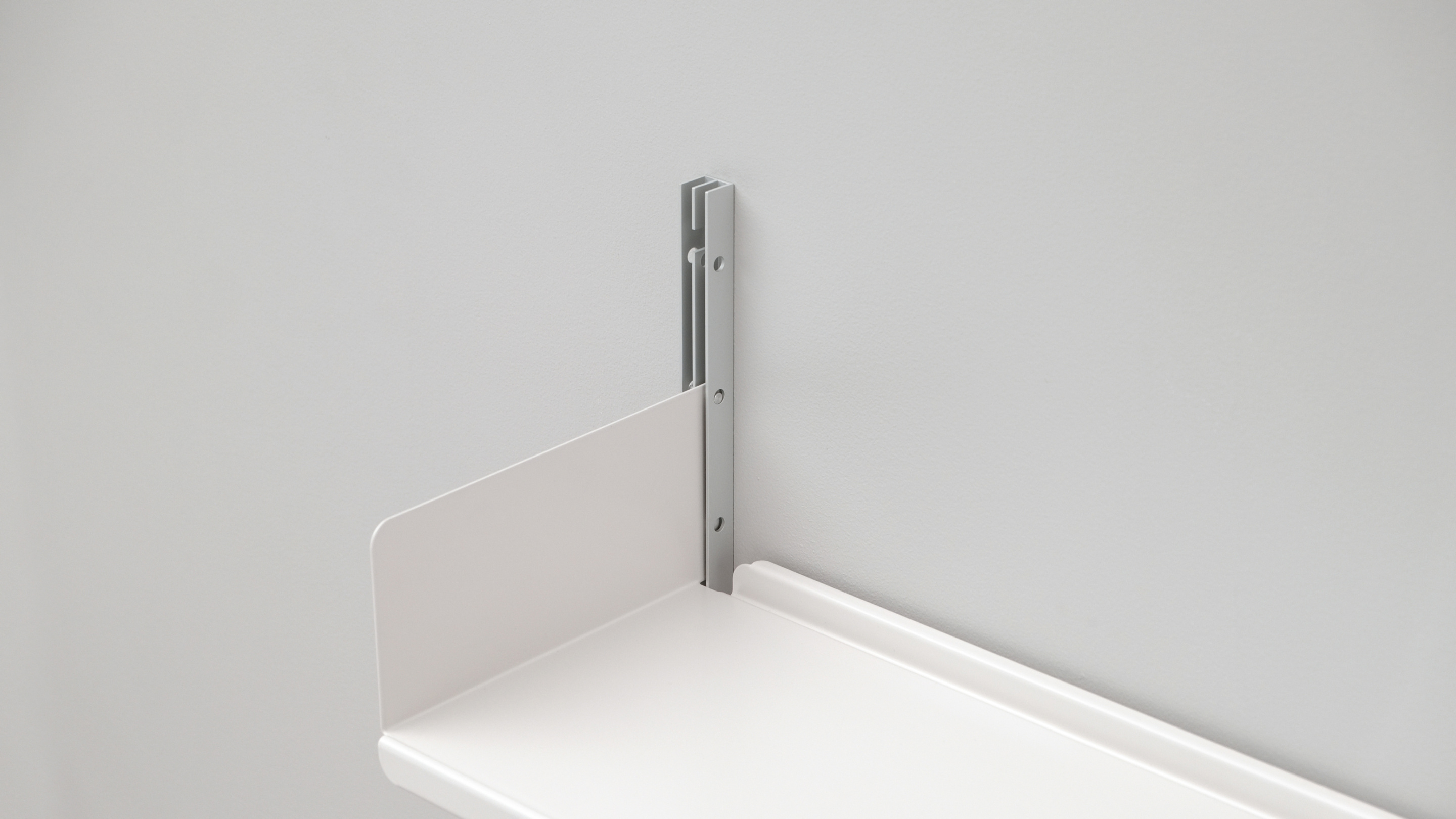How the system works


E-Track
The core of the modular shelving system is the E-Track that attaches directly to a wall for wall-mounted systems, or to the X-Post for semi-wall mounted and compressed systems.


E-Track attached to X-Post
The X-Post can be attached to the wall using wall brackets (for obstructed or uneven walls) and/or compressed between the floor and the ceiling (no walls required).

Interchangeable shelves and cabinets
Shelves, cabinets, desk shelves and tables are simply hung from E-Tracks by slipping the clever notched pins into position – using no tools. Shelves can be used either way up or rotated to form a vertical magnetic surface.
Effortless rearrangement
Two bays combine to suit almost any space
There are two bay widths – narrow 26¼” (26” usable shelf width) and wide 35⅞” (35½” usable shelf width) – which combine to conform to almost any available space. For example, there are 27 possible bay combinations for a 16ft wide wall.



Four interchangeable structures
Wall mounted
Simple, strong and good value – the E-Track is attached directly to almost all types of wall.





Wall type:
Plasterboard wall (medium loading) or solid wall (heavy loading). Lath-and-plaster wall (light loading only).
Components:
E-Tracks, pins and wall-fixings (supplied).
System requirements: ?
Add 1⅜” to each side of the system to ensure enough space for drilling, and fitting pins.
System requirements
To work out the minimum width a system requires, add up the centre-to-centre widths for each bay (26¼” for narrow bays and 35⅞” for wide bays). Then add 1⅜” to each side of the system to ensure enough space for drilling, and fitting your pins.

Semi-wall mounted
If the wall is obstructed or uneven, the E-Track may be attached to an X-Post and stood in front of the wall, held upright by adjustable wall brackets.





Wall and floor type:
Plasterboard wall (medium loading) or solid wall (heavy loading). Lath-and-plaster wall (medium loading). Rigid floor or flexible floor (with added stabilising foot).
Components
E-Tracks, X-Posts, cross rails, wall brackets, pins, wall-fixings (supplied).
System requirements: ?
Add 3” to each side of the system to ensure enough space for X-Posts and floor plates.
System requirements
To work out the minimum width a system requires, add up the centre-to-centre widths for each bay (26¼” for narrow bays and 35⅞” for wide bays). Then add 3” plus the depth of the skirting boards on adjacent walls to ensure enough space for X-Posts and floor plates.

Compressed
Walls not required. E-Tracks may be attached to one or both sides of the X-Post and compressed between the floor and ceiling (this requires holes to be drilled in your ceiling or beam). Can be used as a room divider.





Floor and ceiling type:
Solid ceiling or plaster/plasterboard ceiling. Rigid floor (medium or heavy loading) or flexible floor (with added stabilising foot for light loading).
Components:
E-Tracks, X-Posts (H-Posts for taller systems), cross rails, pins, ceiling-fixings (supplied).
System requirements:
Add 3” to each side of the system to ensure enough space for X-Posts and floor plates.
Free-standing
The E-Track is attached to both sides of the stiffer H-Post, which stands with a pair of stabilising feet. The loading must be distributed evenly to both sides of the shelving system.




Floor type:
Rigid floor (medium loading).
Components
E-Tracks, H-Posts, cross rails, stabilising feet, pins.
System requirements:
The maximum overall height is 75½”.
How strong is the system?
This shelving system has been in continuous production since 1960; it is tried and tested. But, however good the pedigree, any shelving system ultimately relies on the strength of the wall, floor and ceiling to which it is attached.

Reinforcements
The addition of stabilising feet helps compensate for lath-and-plaster walls and/or flexible floors.

Reconfiguring your system
The simple interchangeability of the components encourages either day-to-day rearrangement or complete reconfiguration according to changing needs.
What can I hang on my structure?
You can add shelves, cabinets, desk shelves and tables – in almost any configuration – to your structure. Start with less; rearrange as your life changes; add more later.
Shelves and prices



Frequently asked questions
How do I know what type of wall I have?
The best method to deduce the type of wall is by knocking on the wall. Additionally, the age and type of building can be considered.
As a rough guide: A solid wall is made of masonry, brick or concrete. It sounds true and solid when you tap it with your knuckle. It is ideal.
A plasterboard / gypsum-board wall sounds hollow and consistently crisp wherever you tap. If you are unsure whether a wall is plasterboard / gypsum-board or lath-and-plaster, try running your palm over the surface. A wall that is perfectly straight is likely to be plasterboard / gypsum board, one with undulations is likely to be lath-and-plaster.
A wall which varies from dull to hollow sounding may either have blown plaster or have cavities at some points in the wall.
If in doubt, please consult your planner.
What is light, medium or heavy loading?
Please refer to our planning guide.
What measurements do you need?
To begin, we need to know about your space. Ideally we need some pictures; measurements are essential: the full width and height of your space, not just the area you want to use (see below).
If you can, measure where any sockets, switches or other obstructions appear on your wall – and tell us what your wall is made of.
For more help with measurements, please refer to our planning guide.